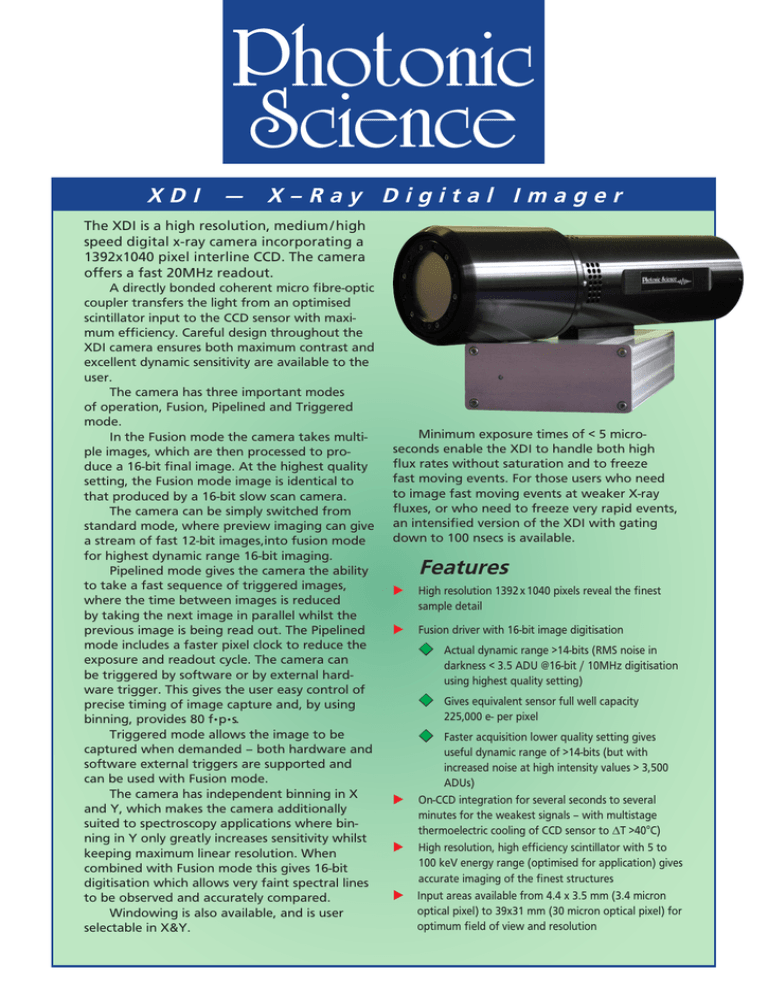Features X D I — X – R a y D i g i t a l I m a g e r
advertisement

Photonic Science XDI — X–Ray Digital Imager The XDI is a high resolution, medium / high speed digital x-ray camera incorporating a 1392x1040 pixel interline CCD. The camera offers a fast 20MHz readout. A directly bonded coherent micro fibre-optic coupler transfers the light from an optimised scintillator input to the CCD sensor with maximum efficiency. Careful design throughout the XDI camera ensures both maximum contrast and excellent dynamic sensitivity are available to the user. The camera has three important modes of operation, Fusion, Pipelined and Triggered mode. In the Fusion mode the camera takes multiple images, which are then processed to produce a 16-bit final image. At the highest quality setting, the Fusion mode image is identical to that produced by a 16-bit slow scan camera. The camera can be simply switched from standard mode, where preview imaging can give a stream of fast 12-bit images,into fusion mode for highest dynamic range 16-bit imaging. Pipelined mode gives the camera the ability to take a fast sequence of triggered images, where the time between images is reduced by taking the next image in parallel whilst the previous image is being read out. The Pipelined mode includes a faster pixel clock to reduce the exposure and readout cycle. The camera can be triggered by software or by external hardware trigger. This gives the user easy control of precise timing of image capture and, by using binning, provides 80 f•p•s. Triggered mode allows the image to be captured when demanded – both hardware and software external triggers are supported and can be used with Fusion mode. The camera has independent binning in X and Y, which makes the camera additionally suited to spectroscopy applications where binning in Y only greatly increases sensitivity whilst keeping maximum linear resolution. When combined with Fusion mode this gives 16-bit digitisation which allows very faint spectral lines to be observed and accurately compared. Windowing is also available, and is user selectable in X&Y. Minimum exposure times of < 5 microseconds enable the XDI to handle both high flux rates without saturation and to freeze fast moving events. For those users who need to image fast moving events at weaker X-ray fluxes, or who need to freeze very rapid events, an intensified version of the XDI with gating down to 100 nsecs is available. Features u High resolution 1392 x 1040 pixels reveal the finest sample detail u Fusion driver with 16-bit image digitisation u Actual dynamic range >14-bits (RMS noise in darkness < 3.5 ADU @16-bit / 10MHz digitisation using highest quality setting) u Gives equivalent sensor full well capacity 225,000 e- per pixel u Faster acquisition lower quality setting gives u u u useful dynamic range of >14-bits (but with increased noise at high intensity values > 3,500 ADUs) On-CCD integration for several seconds to several minutes for the weakest signals – with multistage thermoelectric cooling of CCD sensor to ∆T >40°C) High resolution, high efficiency scintillator with 5 to 100 keV energy range (optimised for application) gives accurate imaging of the finest structures Input areas available from 4.4 x 3.5 mm (3.4 micron optical pixel) to 39x31 mm (30 micron optical pixel) for optimum field of view and resolution XDI — X–Ray Digital Imager Technical Specification Included Items u Input sizes Camera Head Power supply unit, user manual(s), and flight case Drivers for Image Pro Plus range, PSL Image, and LabView PSL tested compatible PCI bus IEEE 1394 FireWire interface card FireWire interconnecting cable: 4.5 m Mains lead for control unit: 1.5m Power supply unit to Camera head: 2m u Optical pixel size u CCD Sensor u CCD Architecture u CCD Bonding u Scintillator u Energy range u Light protection u Digital output u Dynamic Range u Binning u Sub-area readout u CCD gain u Max. Frame Rate u Cooling option u Exposure u Power From 4.4 x 3.6 mm to 39mm x31mm with micro-fibre coherent fibre optic coupling (Other sizes available) From 3.4 to 30 microns depending on input size 1392 (h) x 1040 (v) active pixels: 6.7 microns square Progressive scan with interline transfer Direct micro-fibre optic coupling method Gadolinium oxysuphide; high efficiency, high resolution layer, optimised to application 5 keV to >100 keV X-ray transparent opaque membrane LVDS, FireWire & RS422 parallel differential 12-bit at 20MHz 16-bit at 20MHz – Fusion mode From 1 x 1 to 63 x 63 (independent in X & Y) Independent in X and Y User selectable 10:1 with additional gain boost feature 10 f·p·s @ 1392 x 1040 (>100 f·p·s with binning or sub-area readout) Thermoelectric with air secondary cooling to ∆T >40°C From 5 ms to > 5minutes 110–240 V ac 50/60 Hz autosensing u Dimensions Head Power supply Software Drivers, including 16-bit Fusion driver, for PSL Image and Media Cybernetics’ Image Pro Plus 4.X (Windows O/S including NT/2000 and XP) – Standard The drivers for Media Cybernetics Image Pro Plus 4.X are also suitable for controlling the camera and image acquisition from within any of the other Media Cybernetics software products that use the Image Pro Plus acquisition subroutines Drivers for Labview 5.X (Windows). – Standard PSLink library with DLL and sample C++ code for FireWire driver to assist end-user driver development PC system minimum recommended specifications Pentium 4 processor 1GHz or better 128Mb RAM minimum (256 Mb+ recommended) A GSM Phone connector showing internal pin integrity 74mm Ø x230mm (l) (11.1mm 1:1 input version – larger input sizes will increase size) 290mm x 215mm x 65mm Detail from an image showing the output from a micro capillary x-ray beam collimator (during beam adjustment) Option Lens coupled version for larger input sizes or ‘non-in-line’ configurations Photonic Science Ltd. Tel: +44 (0) 1580 881199 Fax: +44 (0) 1580 880910 Millham, Mountfield, Robertsbridge, East Sussex, TN32 5LA, UK. http://www.photonic-science.co.uk Photonic Science France Tel: +33 476 93 57 20 Fax: +33 476 93 57 22 ZAC Grenoble Air Parc, 38590 Saint Etienne de Saint Geoirs info@photonic-science.co.uk
